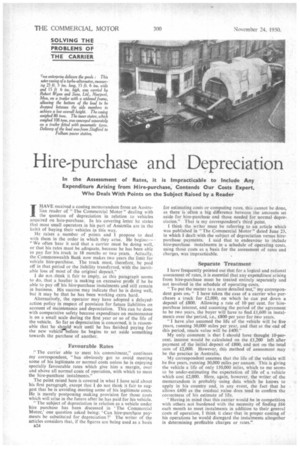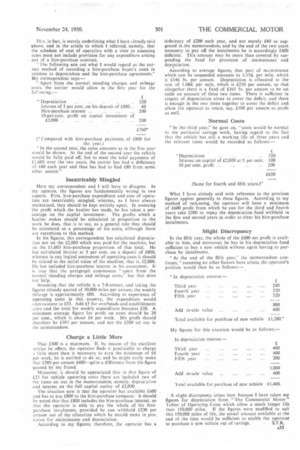Hire-purchase and Depreciation
Page 58

Page 61

If you've noticed an error in this article please click here to report it so we can fix it.
In the Assessment of Rates, it is Impracticable to Include Any Expenditure Arising from Hire-purchase, Contends Our Costs Expert, Who Deals With Points on the Subject Raised by a Reader
1 HAVE received a costing memorandum from an Australian reader of "The Commercial Motor" dealing with the question of depreciation in relation to vehicles acquired on hire-purchase. In his covering letter he states that most small operators in his part of Australia are in the habit of buying their vehicles in this way.
He raises a number of points and I propose to deal with them in the order in which they arise. He begins:— "We often hear it said that a carrier must be doing well, or that his rates must be adequate, because he has been able to pay for his truck in 18 months or two years. Actually, the Commonwealth Bank now makes two years the limit for vehicle hire-purchase. The truck must, therefore, be paid off in that period or the liability transferred, with the inevitable loss of most of the original deposit."
I do not-think it fair to imply, as this paragraph seems to do, that a haulier is making an excessive profit if he be able to pay off his hire-purchase instalments and still remain in business. His success may indicate that he is doing well, but it may be that he has been working extra hard.
Alternatively, the operator may have adopted a delayedaction policy in respect of provision for future liabilities on account of maintenance and depreciation. This can be done with comparative safety because expenditure on maintenance is on a small scale during the first year or so of the life of the vehicle. So far as depreciation is concerned, it is reasonable that he sho_pld wait until he has finished paying for the new vehicIE–before he begins to set aside something towards the purchase of another.
Favourable Rates
" The carrier able to meet his commitment," continues my correspondent, "has obviously got to avoid meeting some of his legitimate or normal costs unless he is enjoying specially favourable rates which give him a margin, over and above all normal costs of operation, with which to meet the hire-purchase instalments."
The point raised here is covered in what I have said about his first paragraph, except that I do not think it fair to suggest that he is avoiding meeting some of his legitimate costs. He is merely postponing making provision for those costs which will arise in the future after he has paid for his vehicle.
"The subject of depreciation in relation to a vehicle under hire purchase has been discussed in 'The Commercial Motor,' one question asked being: 'Can hire-purchase payments be substituted for depreciation ?' The writer of the articles considers that, if the figures are being used as a basis 1324 for estimating costs or computing rates, this cannot be done, as there is often a big difference between the amounts set aside for hire-purchase and those needed for normal depreciation." That is my correspondent's third point.
I think -the writer must be referring to an article which was published in "The Commercial Motor" dated June 23. in which I dealt with the subject of depreciation versus hirepurchase payments. 1 said that to endeavour to include hire-purchase instalments in a schedule of operating costs. using those costs as a basis for the assessment of rates and charges, was impracticable.
Separate Treatment I have frequently pointed out that for a logical and rational assessment of rates, it is essential that any expenditure arising from hire-purchase must be treated entirely separately and not involved in the schedule of operating costs.
"To put the matter to a more detailed test," my correspondent goes one " I have taken the case of a carrier who purchases a truck for £2,000, on which he can put down a deposit of £800. Allowing a rate of 10 per cent. for hirepurchase interest, and assuming the period of the agreement to be two years, the buyer will have to find £1,600 in instalments over the period, i.e., £800 per year for two years.
"I have also assumed the life of the vehicle will be five years, running 30,000 miles per year, and that at the end of this period, resale value will be £400." My only comment is that I should have thought 10-percent. interest would be calculated on the £1,200 left after payment of the initial deposit of £800, and not on the total sum of £2,000. However, this method of assessment may be the practice in Australia. My correspondent assumes that the life of the vehicle will be five years, running 30,000 miles per annum. This is giving the vehicle a life of only 150,000 miles, which to me seems to be under-estimating the expectation of life of a vehicle which cost £2,000. Here, again, however, the writer of the memorandum is probably using data which he knows to apply in his country and, in any event, the fact that he allows £400 as the residual .value does tend to confirm the correctness of his estimate of life.
"Having in mind that this carrier would be in competition with others not burdened with the necessity of finding £66 each month to meet instalments in addition to their general costs of operation, I think it clear that in proper costing of his operations he would disregard the instalments altogether in determining profitable charges or rates." Th.s, in fact, is merely underlining what 1 have already said above, and in the article to which I referred, namely, that the schedule of cost of operation with a view to assessing rates must not include provision for any expenditure arising out of a hire-purchase contract.
The following sets out what 1 would regard as the correct method of recording a hire-purchase buyer's costs in relation to depreciation and the hire-purchase agreements." My correspondent says:—
" Apart from the normal standing charges and mileage costs, the carrier would allow in the first year for the fo'lowing:—
" In the second year, the same amounts as in the first year would be shown. At the end of the second year the vehicle would be fully paid off, but to meet the total payments of £1,600 over the two years, the carrier has had a deficiency of £40 each year and thus has had to find £80 from some other source"
Inextricably Mingled
Here my correspondent and I will have to disagree. In my opinion, the figures are fundamentally wrong in two aspects, First, hire-purchase expenditure and cost of operation are inextricably mingled, whereas, as I have always maintained, they should be kept entirely apart. In assessing the profit which the haulier has made, he has taken a percentage on the capital investment. The profits which a haulier makes should be calculated in proportion to the work he does, that is to say, as a general rule they should be calculated as a percentage of his costs, although there are exceptions to this method.
In his figures, this correspondent has calculated depreciation not on the 12,000 which was paid for the machine, but on the £1,600 hire-purchase proportion of that total. He has calrulated interest at 5 per cent. on a deposit of £800, whereas in any logical assessment of operating costs it should he related to the initial value of the machine, that is, .12,000. He has included hire-purchase interest in his assessment. It ia true that the paragraph commences "apart from the normal 'standing charges and mileage costs," but that does not help.
Assuming that the vehicle is a 7-8-tonner, and taking the figures already quoted of 30,000 miles per annum, the weekly mileage is approximately 600. According to experience of operating costs in this country, the expenditure would 2pproximate to £23. Add £5 for overheads and establishment aosts and the total for weekly expenditure becomes £28. A minimum average figure for profit on costs should be 20 per cent., which is about £6 per week. His profit should therefore be £300 per annum, and not the £200 set out in the memorandum.
Charge a Little More That 1300 is a minimum. If, by reason of the excellent iervice he offers, the operator finds it practicable to charge little more than is necessary to earn the minimum of £6 per week, he is entitled to do so, and he might easily make that £300 per annum £400—qaite a difference from the figure quoted by my friend.
Moreover, it should be appreciated that in that figure of £23 for vehicle operating costs there are included two of the items set out in the memorandum, namely, depreciation and interest on the full capital outlay. of £2,000.
1 he situation now is that the operator has available £600 and has to pay £800 to the hire-purchase company: It should be noted that that £800 includes the hire-purchase interest, so that the operator is able to pay the whole of his hirepurchase instalments, provided he can withhold £200 per annum out of the allocation which he should make in pro7 vision for maintenance and depreciation.
According to my figureS, therefore, the operator has a
deficiency of £200 each year, and not merely £40 as suggested in_the memorandum, and by the end of the two years necessary to pay off the instalments he is accordingly £400 deficient. This amount may be more than covered by suspending the fund for provision of maintenance and depr.eciat ion.
According to average figures, that part of maintenance which can be suspended amounts to 1.17d. per mile, which is £146 Ss. per annum. Depreciation is allocated at the rite of 1.68d. per mile, which is £210 per annum, so that altogether there is a fund of 065 5s, per annum to be set aside on account of these two items. There is sufficient in respect of depreciation alone to cover she deficit, and there is enough in the two items together to cover the deficit and allow the operator to retain, say, £100 per annum as profit as well.
Normal Costs
"In the third year," he goes on, "costs would be normal to the particular cartage work, having regard to the fact that the vehicle has still a working life of three years and the relevant items would be recorded as follows:— What I have already said with reference to the previous figures applies generally to these figures. According to my method of reckoning, the operator will have a minimum of £600 profit from which he can for the third and fourth years take £200 to repay the depreciation fund withheld in the first and second years in order to clear his hire-purchase instalments.
Slight Discrepancy
In the fifth year, the whole of the £600 net profit is available to him, and moreover, he has in his depreciation fund sufficient to buy a new vehicle without again having to purchase by instalments.
"At the end of the fifth year," the memorandum eontinges, "assuming no other factors have arisen, the operator's position would then be as follows:—
A slight discrepancy arises here because I have taken my figures for depreciation from "The Commercial Motor" Tables of Operating Costs which allow a much longer life
than 150,000 miles. If the figures were modified to suit this 150,000 miles of life, the actual amount available at the end of the time would be sufficient to enable the operator to purchase a new vehicle out of savings. S.T.R.




























































































